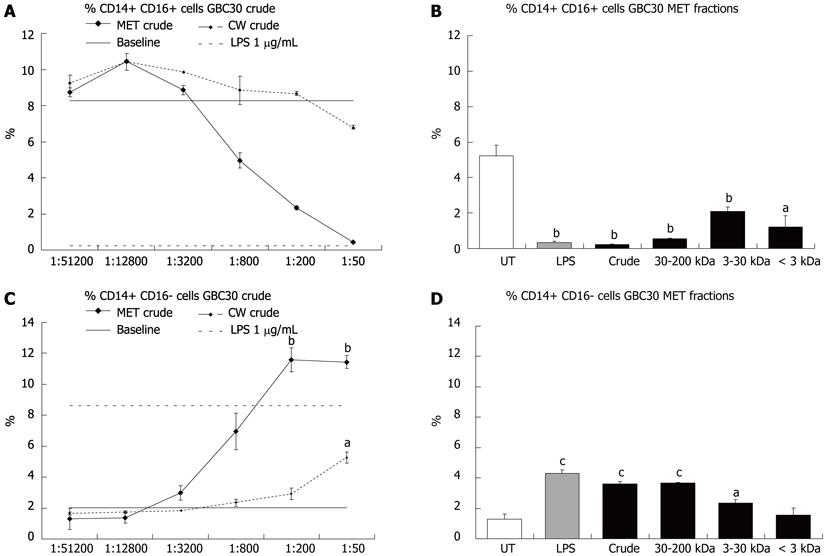Copyright
©2012 Baishideng Publishing Group Co.
World J Gastroenterol. Apr 28, 2012; 18(16): 1875-1883
Published online Apr 28, 2012. doi: 10.3748/wjg.v18.i16.1875
Published online Apr 28, 2012. doi: 10.3748/wjg.v18.i16.1875
Figure 4 Changes in the percent of CD14+ CD16+ and CD14+ CD16- cell populations following exposure of 3-d peripheral blood mononuclear cell cultures to Ganeden Bacillus coagulans 30.
A: Exposure of cells to serial dilutions of Ganeden Bacillus coagulans 30 (GBC30) crude metabolites (MET) led to a strong dose-dependent decrease in CD14 CD16 double positive cells while exposure to cell wall enriched (CW) did not reduce this cell population; B: Treatment of cells with size-selected MET fractions show that all fractions of MET reduce the number of CD14+ CD16+ cells; C: The percent of CD14+ CD14- cells in peripheral blood mononuclear cell cultures increased in cultures treated with crude MET and CW. Treatment with MET resulted in a very strong dose-dependent increase while CW treatment produced a milder increase at the two highest concentrations; D: Treatment of cells with size-selected MET fractions show that only fractions containing high molecular weight compounds increase the number of CD14+ CD16- cells. Bar graphs show data from 1:200 dilutions of each MET fraction and lipopolysaccharide (1 μg/mL). aP < 0.05, bP < 0.01 and cP < 0.001. For each data point, the mean + SD are shown for each duplicate data set. Graphs show data representative of 1 out of 3 experiments. UT: Untreated; LPS: Lipopolysaccharide.
-
Citation: Benson KF, Redman KA, Carter SG, Keller D, Farmer S, Endres JR, Jensen GS. Probiotic metabolites from
Bacillus coagulans GanedenBC30TM support maturation of antigen-presenting cellsin vitro . World J Gastroenterol 2012; 18(16): 1875-1883 - URL: https://www.wjgnet.com/1007-9327/full/v18/i16/1875.htm
- DOI: https://dx.doi.org/10.3748/wjg.v18.i16.1875









